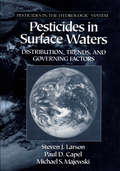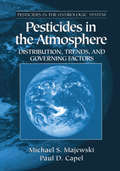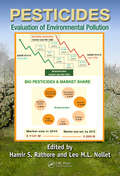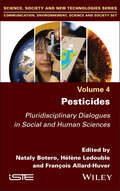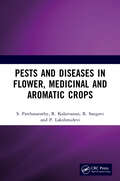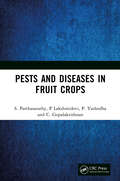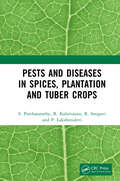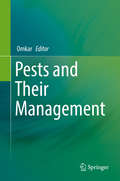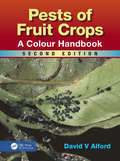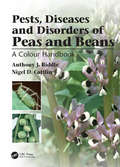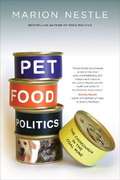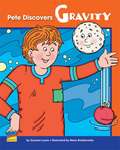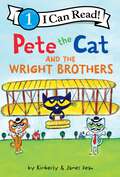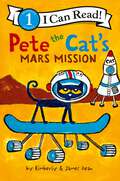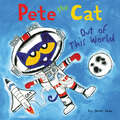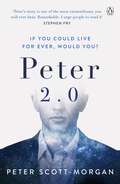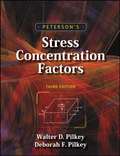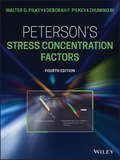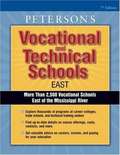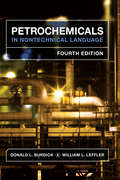- Table View
- List View
Pesticides in Surface Waters: Distribution, Trends, and Governing Factors
by Steven J. LarsonPesticde use in agriculture and non-agriculture settings has increased dramatically over the last several decades. Concern about adverse effects on the environment and human health has spurred an enormous amount of research into their environmental behavior and fate. Pesticides in Surface Waters presents a comprehensive summary of this research.<BR
Pesticides in the Atmosphere: Distribution, Trends, and Governing Factors
by Michael S. MajewskiMost people know about the presence and health effects of pesticide residues in the water they drink. However, they may not realize the impact of atmospheric transportation and deposition of pesticides on water quality. Scientific studies of pesticides in various atmospheric matrices (air, rain, snow, aerosols, and fog) provide some of the answers.
Pesticides, Organic Contaminants, and Pathogens in Air: Chemodynamics, Health Effects, Sampling, and Analysis
by James N. Seiber Thomas M. CahillThe air is an important but largely unrecognized source of contaminant fate in the environment, including transport of pesticides and contaminants to nontarget areas and exposures for people and wildlife. This book summarizes and places in perspective the potential transport, transformation, and health implications of pesticides and contaminants in air, including the air we breathe. It delves into the hypothesis that the atmosphere is the most significant environmental compartment affecting the overall transport and fate of many classes of environmental contaminants. The authors draw parallels between sampling, analysis, and impact of airborne toxics and particulate matter with the COVID-19 pandemic. Airborne viruses and fine particulate matter, which are of similar size, have remarkable parallels in how they are transmitted and accumulated in the respiratory tract. FEATURES Assesses exposures of people and wildlife to airborne chemicals Includes case study applications, with relevant data summarized for pesticides and contaminants in air Discusses approaches to modeling pesticides’ and contaminants’ dispersion and fate in air Includes an assessment of the physicochemical properties of pesticides and contaminants that influence sampling and atmospheric mobility and fate The authors are global experts in air contaminant research, and this book is well organized and helpful for people interested in regulatory, health, and other topics related to pesticides and contaminants in air. James N. Seiber is a Professor Emeritus at the University of California, Davis. Thomas A. Cahill is an Associate Professor in the School of Mathematical and Natural Sciences at Arizona State University.
Pesticides: Evaluation of Environmental Pollution
by Leo M.L. Nollet Hamir S. RathorePesticides play an important role in controlling pests that carry diseases and threaten crop production. In recent years, however, there has been increased concern about the adverse impacts of pesticides and their degradation products on public health and the environment. A considerable amount of work is being done to develop nonchemical methods of
Pesticides: Pluridisciplinary Dialogues in Social and Human Sciences (ISTE Invoiced)
by Hélène Ledouble Nataly Botero François Allard-HuverThe use of pesticides is a subject of intense public debate. Whether in media, legal, terminological or political terms, the subject is migrating from a strictly agricultural universe to a global, social problem. Given the complexity of current and future issues, Pesticides provides a forum for multidisciplinary dialogue and debate on plant protection products within the humanities and social sciences. It presents reflections on the discursive and argumentative activity of the various players and arenas in the debate, and on the development and testing of consensus through controversy and counter-discourse. This book examines the scientific and communication practices of economic and industrial players (influence and lobbying), agricultural practices in terms of pesticide exposure, and the legal proceedings and initiatives of local authorities and associations. It also seeks to shed light on the media coverage of health and environmental issues surrounding pesticides.
Pests and Diseases in Flower, Medicinal and Aromatic Crops
by S. Parthasarathy P. Lakshmidevi R. Kalaivanan R. SangaviEffective management of pests and diseases is crucial for the successful and profitable cultivation of crops. To address this need, this book compiles essential information and offers a simple approach to pest, disease, and nematode diagnosis, making it easier for students and non-specialists to tackle the challenges they face in this field. The subject matter details pest management in flower, medicinal and aromatic crops, using different methods and integrated pest management.This book is aimed at students pursuing Agriculture, Horticulture, Botany, Forestry, and Zoology, and non-specialists such as government officials, agricultural workers, horticulturists, extension workers, and professionals in the corporate sector.Print edition not for sale in India.
Pests and Diseases in Fruit Crops
by S. Parthasarathy C. Gopalakrishnan P Lakshmidevi P. YashodhaThis book provides information about the major diseases of horticultural crops in India and discusses the significant pest, disease, and nematode issues affecting essential fruit crops in the country. It also addresses the management of pests in vegetable crops through several methods such as regulatory, physical, cultural, chemical, and biological approaches, host resistance, and integrated pest management strategies. Print edition not for sale in South Asia (India, Sri Lanka, Nepal, Bangladesh, Pakistan and Bhutan)
Pests and Diseases in Spices, Plantation and Tuber Crops
by S. Parthasarathy P. Lakshmidevi R. Kalaivanan R. SangaviEffective management of pests and diseases is crucial for the successful and profitable cultivation of crops. To address this need, this book compiles essential information and offers a simple approach to pest, disease, and nematode diagnosis, making it easier for students and non-specialists to tackle the challenges they face in this field. The subject matter details pest management in plantation, spice, and tuber crops, using methods like regulatory, physical, cultural, chemical, biological, and integrated pest management.This book is aimed at students pursuing Agriculture, Horticulture, Botany, Forestry, and Zoology, and non-specialists such as government officials, agricultural workers, horticulturists, extension workers, and professionals in the corporate sector.Print edition not for sale in India.
Pests and Diseases in Vegetable Crops
by S. Parthasarathy C. Gopalakrishnan P Lakshmidevi P. YashodhaThis book provides information about the major diseases of horticultural crops in India. It discusses the pest, disease, and nematode issues affecting essential vegetable crops in the country. The management of pests in vegetable crops has been addressed through many methods, including regulatory, physical, cultural, chemical, and biological approaches, host resistance, and integrated pest management strategies. The subject matter of the book is helpful for farmers who cultivate vegetable crops and is a valuable reference point for policymakers, researchers, extension workers, and students. Print edition not for sale in South Asia (India, Sri Lanka, Nepal, Bangladesh, Pakistan and Bhutan)
Pests and Their Management
by OmkarThis book comprehensively compiles information on some of the major pests that afflict agricultural, horticultural and medicinal crops in particular as well as many polyphagous pests. Not only does this book deal with the pests of common globally produced crops it also addresses those of rarely dealt with crops such as seed spices, medicinal and aromatic plants. While the perspective of insect pests is largely Indian and South East Asian in context, the book does deal with globally problematic pests, particularly polyphagous ones. Not only will the readers be acquainted with the pests, their damaging potential and their life cycle but also with the latest methods of managements including ecofriendly measures being employed to keep pest populations at manageable levels. The 27 chapters in the book, are grouped into four sections primarily based on crop types, viz. pest of agricultural, horticultural and medicinal crops, and polyphagous pests, making the book easy to navigate. Each of the chapters is comprehensive and well illustrated and written by academicians who have dedicated their entire lives to the study of a particular crop-pest complex. The final chapter of this book provides an overview on the principles and processes of pest management.
Pests of Fruit Crops: A Colour Handbook, Second Edition
by David V AlfordPests of Fruit Crops: A Colour Handbook, Second Edition provides an up-to-date illustrated account of the various pests of fruit crops throughout Europe, many of which (or their close relatives) are also present in non-European countries. In fact, several pose problems on fruit crops worldwide. This authoritative book focuses on insect and mite pes
Pests of Landscape Trees and Shrubs (Second Edition)
by Steve H. Dreistadt Jack Kelly Clark Mary Louise FlintThis is the ultimate guide to managing landscape pests! With this manual in hand you will be able to diagnose and manage hundreds of insect, mite, weed, plant disease, and nematode pests. Inside you'll find updated information on how to use environmentally safe, ecologically based IPM methods; landscape designs that prevent pests; how to select resistant varieties; advice on the use of less-toxic pesticides such as botanicals, oils, and soaps; and tips on planting, irrigating, and other plant-care cultural activities that help in avoiding problems. Contains over one hundred pages of easy-to-use tree and shrub pest tables; invaluable in helping you identify common pest problems now on over 200 types of ornamental trees and shrubs. Includes 432 color photographs, 117 drawings and tables, references, glossary, and an index.
Pests, Diseases and Disorders of Peas and Beans: A Colour Handbook (Manson Ser.)
by Anthony J. Biddle Nigel CattlinAnthony Biddle is among the most respected scientists in the pea and bean industry worldwide. Nigel Cattlin has an international reputation for agricultural and horticultural photography of the highest order. They have created between them a concise and practical guide to the protection of pea and bean crops, with descriptions of symptoms linked th
Pet Food Politics: The Chihuahua in the Coal Mine
by Marion NestleMarion Nestle, acclaimed author of Food Politics,now tells the gripping story of how, in early 2007, a few telephone calls about sick cats set off the largest recall of consumer products in U.S. history and an international crisis over the safety of imported goods ranging from food to toothpaste, tires, and toys. Nestle follows the trail of tainted pet food ingredients back to their source in China and along the supply chain to their introduction into feed for pigs, chickens, and fish in the United States, Canada, and other countries throughout the world. What begins as a problem "merely" for cats and dogs soon becomes an issue of tremendous concern to everyone. Nestle uncovers unexpected connections among the food supplies for pets, farm animals, and people and identifies glaring gaps in the global oversight of food safety.
Pete Discovers Gravity
by Anne Flounders Suzanne Lyons Mena DolobowskyThis story is about gravity. (Set of 6 with Common Core Editions of Teacher Materials)
Pete the Cat and the Wright Brothers (I Can Read Level 1)
by Kimberly Dean James DeanPete the Cat helps the Wright brothers build their first flying machine in this historical fiction Level 1 I Can Read from New York Times bestselling creators Kimberly and James Dean. When Pete the Cat learns that the Wright brothers' flying machine can’t fly without the wind, he has an idea. What if it didn’t need wind to fly? Together, the cats invent the perfect solution. Pete may even get the chance to fly! This early reader includes an author’s note about the real life Wright brothers and the true story of the first flight. Find out in this Level 1 I Can Read book complete with original illustrations from the creators of Pete the Cat, Kimberly and James Dean. Pete the Cat and the Wright Brothers is perfect for children learning to sound out words and sentences. Whether shared at home or in a classroom, the short sentences, familiar words, and simple concepts of Level One books support success for children eager to start reading on their own.
Pete the Cat's Mars Mission (I Can Read Level 1)
by Kimberly Dean James DeanPete the Cat travels to Mars to help his friend in this Level 1 I Can Read from New York Times bestselling creators Kimberly and James Dean. Marty is stuck on Mars, and it’s up to Pete the Cat to rescue him! Will Pete have the tools he needs to get Marty home?Find out in this Level 1 I Can Read book complete with original illustrations from the creators of Pete the Cat, Kimberly and James Dean. Pete the Cat's Mars Mission is perfect for children learning to sound out words and sentences. Whether shared at home or in a classroom, the short sentences, familiar words, and simple concepts of Level One books support success for children eager to start reading on their own.
Pete the Cat: Out of This World (Pete the Cat)
by Kimberly Dean James DeanBlast off into space with New York Times bestselling author and artists James Dean and everyone’s favorite cat-stronaut, Pete the Cat, in Pete the Cat: Out of This World.When Pete heads off to space camp, he gets to float in zero gravity, build rockets, and even goes on an extraordinary interstellar mission that is out of this world—literally. Houston, ready to rock out with Pete the Cat!Don't miss Pete's other storybook adventures, including Pete the Cat: Construction Destruction, Pete the Cat: Cave-cat Pete, Pete the Cat and the Treasure Map, Pete the Cat: Robo-Pete, and more!
Peter 2.0: The Human Cyborg
by Peter Scott-MorganThe incredible book behind the primetime Channel 4 documentary, Peter: The Human Cyborg'A remarkable account of what it means to be human and what technology can really achieve' Sunday Telegraph'Peter's story is one of the most extraordinary you will ever hear. I urge people to read it' Stephen Fry'A remarkable story . . . you're left desperate to take nothing for granted' Radio Times __________ Peter, a brilliant scientist, is told that he will lose everything he loves. His husband. His family. His friends. His ability to travel the world. All will be gone. But Peter will not give up. He vows that this will not be the end and instead seeks a completely new beginning . . . Peter has Motor Neurone Disease, a condition universally considered by doctors to be terminal. He is told it will destroy his nerve cells and that within about two years, it will take his life too. But, face-to-face with death, he decides there is another way. Using his background in science and technology, he navigates a new path, one that will enable him not just to survive, but to thrive. This is the astonishing true story about Peter Scott-Morgan: the first person to combine his very humanity with artificial intelligence and robotics to become a full Cyborg. His discovery means that his terminal diagnosis is negotiable, something that will rewrite the future.And change the world. By embracing love, life and hope rather than fear, tragedy and despair, he will become Peter 2.0. __________'Compelling . . . Scott-Morgan is a true one-off. It is in the telling of the love story, rather than the technical details of becoming a cyborg, that this book succeeds' The Times 'What's striking is Peter's constant optimism, bravery and his ability to find radical answers to problems that have confounded Britain's brightest minds' Daily Telegraph 'A soaring love story' Financial Times 'Fascinating and extremely moving' Sun
Peterson's Stress Concentration Factors
by Deborah F. Pilkey Walter D. PilkeyPeterson's Stress Concentration Factors establishes and maintains a system of data classification for all of the applications of stress and strain analysis and expedites their synthesis into CAD applications. Substantially revised and completely updated, this book presents stress concentration factors both graphically and with formulas. It also employs computer-generated art in its portrayal of the various relationships between the stress factors affecting machines or structures. These charts provide a visual representation of the machine or structure under consideration as well as graphs of the various stress concentration factors at work. They can be easily accessed via an illustrated table of contents that permits identification based on the geometry and loading of the location of a factor. For the new third edition, new material will be added covering finite element analyses of stress concentrations, as well as effective computational design. The book explains how to optimize shape to circumvent stress concentration problems and how to achieve a well-balanced design of structures and machines that will result in reduced costs, lighter products, and improved performance.
Peterson's Stress Concentration Factors
by Deborah F. Pilkey Walter D. Pilkey Zhuming BiThe bible of stress concentration factors—updated to reflect today's advances in stress analysis This book establishes and maintains a system of data classification for all the applications of stress and strain analysis, and expedites their synthesis into CAD applications. Filled with all of the latest developments in stress and strain analysis, this Fourth Edition presents stress concentration factors both graphically and with formulas, and the illustrated index allows readers to identify structures and shapes of interest based on the geometry and loading of the location of a stress concentration factor. Peterson's Stress Concentration Factors, Fourth Edition includes a thorough introduction of the theory and methods for static and fatigue design, quantification of stress and strain, research on stress concentration factors for weld joints and composite materials, and a new introduction to the systematic stress analysis approach using Finite Element Analysis (FEA). From notches and grooves to shoulder fillets and holes, readers will learn everything they need to know about stress concentration in one single volume. Peterson's is the practitioner's go-to stress concentration factors reference Includes completely revised introductory chapters on fundamentals of stress analysis; miscellaneous design elements; finite element analysis (FEA) for stress analysis Features new research on stress concentration factors related to weld joints and composite materials Takes a deep dive into the theory and methods for material characterization, quantification and analysis methods of stress and strain, and static and fatigue design Peterson's Stress Concentration Factors is an excellent book for all mechanical, civil, and structural engineers, and for all engineering students and researchers.
Peterson's Vocational and Technical Schools East (7th Edition)
by Peterson'sA guide book for users to compare the vocational programs in East side of the United States that offer training for many of today's hottest jobs.
Peterson's Vocational and Technical Schools West (7th Edition)
by Peterson'sA guide book for readers to compare the vocational programs in the Western United States that offer training for many of today's hottest jobs.
Petro-Aggression
by Jeff D. ColganOil is the world's single most important commodity and its political effects are pervasive. Jeff Colgan extends the idea of the resource curse into the realm of international relations, exploring how countries form their foreign policy preferences and intentions. Why are some but not all oil-exporting 'petrostates' aggressive? To answer this question, a theory of aggressive foreign policy preferences is developed and then tested, using both quantitative and qualitative methods. Petro-Aggression shows that oil creates incentives that increase a petrostate's aggression, but also incentives for the opposite. The net effect depends critically on its domestic politics, especially the preferences of its leader. Revolutionary leaders are especially significant. Using case studies including Iraq, Iran, Libya, Saudi Arabia and Venezuela, this book offers new insight into why oil politics has a central role in global peace and conflict.
Petrochemicals in Nontechnical Language (Pennwell Nontechnical Ser.)
by Donald L. Burdick Wiliam L. LefflerAuthors Don Burdick and Bill Leffler have completely rewritten this time-honored bestseller, now the definitive book for understanding the mysteries of the petrochemical industry. With chapters on all the base chemicals and derivatives, plus seven new ones covering the Fischer-Tropsch process, polyurethane, epoxy resins and more, this is broadest available look inside the industry. Still offering readers easy-to-understand diagrams, charts and tables, plus digestible chapter reviews - this classic delivers the information that every person in the industry needs.
